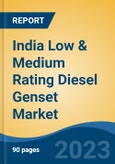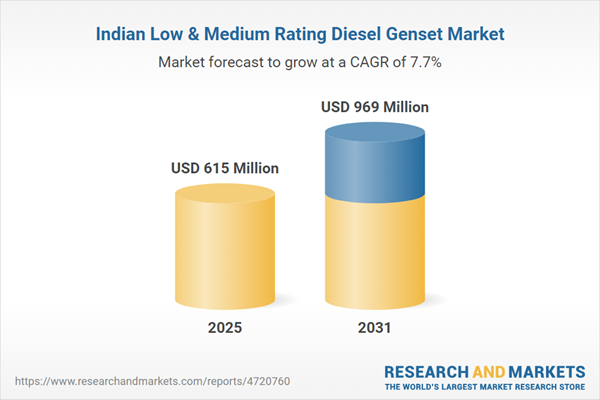Free Webex Call
The India Low & Medium Rating Diesel Genset Market was valued at USD 615 Million in 2025 and is projected to reach USD 969 Million by 2031, rising at a CAGR of 7.72%. Low and Medium Rating Diesel Gensets, typically ranging from 5 kVA to 500 kVA, are essential power backup solutions across various residential, commercial, and small-to-midscale industrial applications. These gensets provide reliable electricity in locations where power supply is inconsistent or unavailable, making them highly suitable for schools, healthcare facilities, construction sites, residential complexes, and small manufacturing units. Speak directly to the analyst to clarify any post sales queries you may have.
10% Free customizationThis report comes with 10% free customization, enabling you to add data that meets your specific business needs.
Low-rating gensets (up to 100 kVA) cater primarily to emergency power needs for low-load applications, while medium-rating gensets (100 kVA-500 kVA) are more robust, supporting multiple systems or machines simultaneously. These gensets are valued for their compact size, fuel efficiency, operational reliability, and adaptability to diverse usage conditions. Many come equipped with automatic start systems, soundproof enclosures, and advanced monitoring controls for enhanced user convenience.
In India, where grid stability remains a concern in many regions, especially Tier II and Tier III cities, these gensets serve as a dependable source of continuous or standby power. Their versatile use and affordability contribute to sustained demand across sectors.
Key Market Drivers
Inconsistent Power Supply and Grid Infrastructure
Frequent power outages and unstable electricity infrastructure continue to be major factors driving the demand for low and medium rating diesel gensets in India. While urban areas may experience better grid connectivity, many semi-urban and rural zones still face significant disruptions due to transmission failures, maintenance issues, and seasonal overloads. This makes gensets a vital solution for ensuring uninterrupted power supply in essential services like healthcare, education, retail, and local governance.These gensets are particularly useful in Tier 2 and Tier 3 cities where aging or overburdened grid systems are unable to meet rising electricity demands. The ability of diesel gensets to provide quick and reliable power without requiring complex installation has made them the preferred backup option for households, small enterprises, and institutions.
Government initiatives such as Saubhagya have improved access to electricity in remote areas, but uninterrupted supply remains a challenge. In such regions, gensets bridge the power gap effectively. According to the Central Electricity Authority (CEA), India experiences an estimated 50-60 million man-hours of power outages annually, particularly in underserved regions, reinforcing the need for dependable genset solutions.
Key Market Challenges
Rising Environmental Regulations and Emission Norms
The tightening of emission standards and environmental compliance measures poses a significant challenge to the low and medium rating diesel genset market in India. Diesel generators are known to emit pollutants including particulate matter, nitrogen oxides, and carbon dioxide, contributing to air quality issues in both urban and rural areas. As a result, the Central Pollution Control Board (CPCB) has mandated compliance with phased emission norms, including the recent CPCB IV+ standards.While these regulations are necessary for environmental health, they increase manufacturing costs due to the incorporation of advanced emission-control technologies such as diesel particulate filters (DPF) and selective catalytic reduction (SCR) systems. This cost burden is particularly difficult for smaller buyers - such as SMEs, housing societies, and educational institutions - who may delay or avoid purchasing new compliant gensets.
Moreover, regional restrictions, especially in highly polluted cities like Delhi, Mumbai, and Bengaluru, have limited genset usage during critical periods, prompting a gradual shift toward alternative power solutions. The resulting uncertainty affects both production planning and customer purchasing behavior. To remain competitive, manufacturers are now required to invest in sustainable and affordable genset models that comply with new norms while still appealing to price-sensitive segments.
Key Market Trends
Shift Toward Hybrid Power Solutions
A notable trend shaping the India Low & Medium Rating Diesel Genset Market is the rising adoption of hybrid energy systems that integrate diesel gensets with renewable power sources such as solar or battery storage. These hybrid configurations are increasingly preferred in sectors such as telecom, healthcare, education, and remote infrastructure, where continuous power supply is critical but fuel costs and emissions are concerns.By combining solar panels or battery units with diesel gensets, users can minimize diesel usage, reduce operating expenses, and improve sustainability. In many off-grid or semi-grid regions, these systems offer a practical alternative by reducing dependence on diesel fuel, which is costly and logistically challenging to supply in remote areas.
The declining cost of solar equipment and battery storage, combined with increased awareness of environmental issues, has made hybrid genset setups more viable. Manufacturers are now offering gensets with smart energy controllers that automatically manage the power mix based on energy demand and availability, optimizing efficiency and reducing wear on genset components.
This trend aligns with India’s larger energy transition goals, supporting cleaner, decentralized power models and offering long-term value to users.
Key Players Profiled in this India Low & Medium Rating Diesel Genset Market Report
- Cummins India Limited
- Kirloskar Electric Company Ltd.
- Mahindra Powerol Ltd.
- Kohler Power India Ltd.
- Ashok Leyland Ltd.
- Luminous Power Technologies Pvt. Ltd.
- Perkins Engines Company Limited (India)
- Honda Siel Power Products Ltd.
Report Scope:
In this report, the India Low & Medium Rating Diesel Genset Market has been segmented into the following categories, in addition to the industry trends which have also been detailed below:India Low & Medium Rating Diesel Genset Market, by Rating:
- Low Rating
- Medium Rating
India Low & Medium Rating Diesel Genset Market, by kVA Rating:
- 5 kVA - 50 kVA
- 50.1 kVA - 100 kVA
- 100.1 kVA - 162.5 kVA
India Low & Medium Rating Diesel Genset Market, by End User:
- Residential
- Commercial
- Industrial
India Low & Medium Rating Diesel Genset Market, by Region:
- South India
- North India
- West India
- East India
Competitive Landscape
Company Profiles: Detailed analysis of the major companies present in the India Low & Medium Rating Diesel Genset Market.Available Customizations:
With the given market data, the publisher offers customizations according to a company's specific needs. The following customization options are available for the report.Company Information
- Detailed analysis and profiling of additional market players (up to five).
This product will be delivered within 1-3 business days.
Table of Contents
1. Product Overview
2. Research Methodology
3. Executive Summary
5. India Low & Medium Rating Diesel Genset Market Outlook
6. South India Low & Medium Rating Diesel Genset Market Outlook
7. North India Low & Medium Rating Diesel Genset Market Outlook
8. West India Low & Medium Rating Diesel Genset Market Outlook
9. East India Low & Medium Rating Diesel Genset Market Outlook
10. Market Dynamics
11. Market Trends & Developments
14. Company Profiles
Companies Mentioned
The leading companies profiled in this India Low & Medium Rating Diesel Genset market report include:- 1. Cummins India Limited
- 2. Kirloskar Electric Company Ltd.
- 3. Mahindra Powerol Ltd.
- 4. Kohler Power India Ltd.
- 5. Ashok Leyland Ltd.
- 6. Luminous Power Technologies Pvt. Ltd.
- 7. Perkins Engines Company Limited (India)
- 8. Honda Siel Power Products Ltd.
Table Information
| Report Attribute | Details |
|---|---|
| No. of Pages | 80 |
| Published | May 2025 |
| Forecast Period | 2025 - 2031 |
| Estimated Market Value ( USD | $ 615 Million |
| Forecasted Market Value ( USD | $ 969 Million |
| Compound Annual Growth Rate | 7.7% |
| Regions Covered | India |
| No. of Companies Mentioned | 8 |









